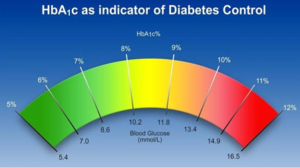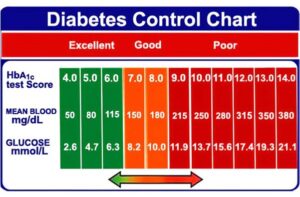
07 Oct All About Diabetes Tests: Understand Your Blood Sugar the Easy Way
All About Diabetes Tests: Understand Your Blood Sugar the Easy Way
Nowadays, diabetes is one of the most prevalent medical conditions worldwide. Millions of individuals are impacted by it, and many of them are unaware of it. Prolonged surveillance and early discovery might help avoid major consequences like renal issues, nerve damage, heart disease, and eyesight loss.
Blood sugar checks using basic blood tests are one of the greatest strategies to treat diabetes or detect it early. It can be perplexing, too, with titles like HbA1c, Random Sugar, Postprandial Sugar, and Fasting Sugar.

What is blood sugar?
Your body uses glucose, often known as blood sugar, as its primary energy source. Our diets, particularly those high in carbohydrates like bread, rice, fruits, and sweets, provide us with glucose. The pancreas secretes the hormone insulin, which facilitates the transfer of blood sugar into your body’s cells for energy.
Sugar remains in the blood rather than entering the cells when your body is unable to use insulin effectively or produces insufficient amounts of it. This results in hyperglycemia, or elevated blood sugar, which is the hallmark of diabetes.

What Are the Primary Diabetes Tests?
To identify and track diabetes, four tests are frequently used:
1. Fasting Blood Sugar (FBS)
It is a test that checks blood sugar levels after eight hours or more without eating.
It provides a clear image of your baseline blood sugar level without the influence of food, which is why it is done.
The procedure involves drawing a tiny amount of blood, usually before breakfast in the morning.
Normal values:
- Less than 100 mg/dL – Normal
- 100 to 125 mg/dL – Prediabetes (borderline high)
- 126 mg/dL or above – Diabetes
When diagnosing diabetes or determining if your blood sugar is under control, this test is frequently the initial step.
2. Postprandial Blood Sugar (PPBS or PP Test)
It is a test conducted two hours following a typical lunch.
The purpose is to see how your body responds to sugar from food.
The procedure involves drawing a tiny amount of blood, two hours after your typical meal or lunch.
Normal values:
• Less than 140 mg/dL – Normal
• 140 to 199 mg/dL – Prediabetes
• 200 mg/dL or more – Diabetes
You may assess how much your blood sugar climbs after a meal by using the PP test. It is particularly helpful for monitoring insulin action.
3.Random Blood Sugar (RBS)
It is a blood sugar test that may be performed whenever you choose, regardless of when you last had food.
It’s done to rapidly monitor blood sugar levels, particularly in those exhibiting symptoms like increased thirst, exhaustion, or frequent urination.
The procedure involves drawing a tiny amount of blood at any time of day.
Normal values:
• Below 140 mg/dL – Normal
• Above 200 mg/dL with symptoms – Likely Diabetes (confirmation needed)
This rapid screening method is frequently utilized in medical camps or emergencies.
4. HbA1c (Glycated Hemoglobin)
It is a test that displays your blood sugar average over the previous two to three months.
The purpose is to track long-term sugar control. It indicates the amount of sugar that has adhered to your red blood cells.
Method: No fasting is required. a quick blood test whenever you want.
Normal values:
• Below 5.7% – Normal
• 5.7% to 6.4% – Prediabetes
• 6.5% or above – Diabetes
In order to track how effectively a diabetic patient is controlling their blood sugar levels through diet, exercise, or medication, doctors mostly rely on HbA1c.
Which Test Should You Take?
Depending on your circumstances:
• FBS and HbA1c are typically the primary options for an early diagnosis.
• Use the PP test to measure blood sugar levels after meals.
• Random Sugar can be helpful if you have symptoms and need a rapid check.
• The best way to see long-term sugar management is with HbA1c.
For a complete picture, your doctor might suggest one or more of these tests in combination.
Why These Tests Matter ?
Many diabetics don’t initially exhibit any noticeable symptoms. Some people can overlook minor symptoms like fatigue, hazy vision, or changes in weight. Frequent blood sugar checks can:
• Early detection of prediabetes
• Avoid complications by receiving treatment on time.
• Assist in tracking the effectiveness of your present treatment.
• Promote dietary and lifestyle modifications that are healthy.
Symptoms That Should Not Be Ignored
If you have any of these signs, it’s time to get tested:
- Feeling tired all the time
- Increased thirst or hunger
- Frequent urination
- Unexplained weight loss
- Blurry vision
- Slow healing of wounds
Even if you feel healthy, routine health check-ups are recommended, especially if you:
- Are over 40 years old
- Are overweight or obese
- Have a family history of diabetes
- Have high blood pressure or high cholesterol
- Have had gestational diabetes during pregnancy
Visit the Vision Diagnostic Center to get tested.
All of the main blood sugar tests are available at Vision Diagnostic Centre under one roof, including:
✅ Fast and accurate reports
✅ Reasonably priced
✅ Skilled lab technicians and phlebotomists
✅ Family-friendly health packages and discounts
Conclusion: Stay One Step Ahead of Diabetes
Although diabetes may be a chronic illness, it can be successfully managed with consistent monitoring and wise lifestyle decisions.
Avoid waiting for symptoms to worsen. Take control of your health by scheduling your test right now. Our top priority at Vision Diagnostic Centre is your well-being.


No Comments